EDITOR’S NOTE: Traveleater Rachel of Jackfruit Adventure shares with us the top five hidden eateries you need to check out on your next visit to Saigon’s Chinatown.
If you come to Saigon and skip District 5, you’ve only seen half the city.
This is where the city first learned to speak in many languages. Long before skyscrapers shaped the skyline of District 1, Chinese migrants crossed the canal and built a life from scratch. They brought their own rhythms and recipes – preserving meats, brewing teas, folding dumplings with care. Families grew up in alleys filled with the scent of incense, the sound of woks, and the comfort of shared meals.
District 5 is still Saigon’s real Chinatown. Not the kind dressed in neon signs or built for tourists, but a living neighborhood where tradition is carried out by hand. Restaurants open when the owner is ready. Recipes are passed down in quiet conversations, not written on boards. The walls are stained with steam and regulars don’t need to ask for their usual.
This isn’t Chinese food in Vietnam. It’s Vietnamese life shaped by Chinese hands and seasoned with decades of quiet care. The kind you don’t find in travel apps but in places where stories linger in each bowl.
Here are five spots where that story is still being told. Gently, generously, and without fanfare.
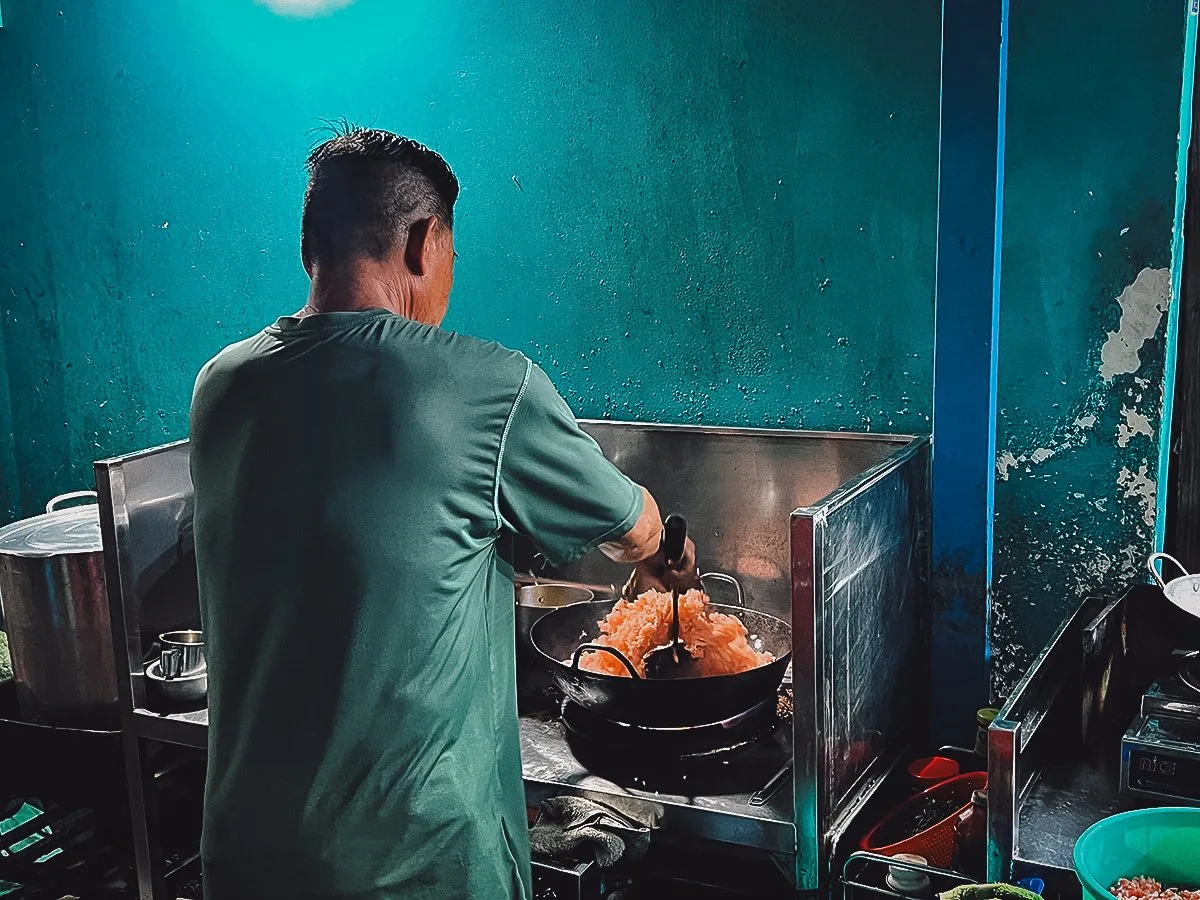
LOCAL FAVORITES IN HO CHI MINH CITY’S CHINATOWN
1. Hủ tiếu sa tế Tô Ký (To Ky satay noodle soup)
Tô Ký is where Saigon’s satay noodle soup quietly found its home. This shop has been run by the same Teochew-Chinese family since the 1940s. It started with Mr. Tô Cẩm, who brought his deep, fragrant broth recipes from China to Chợ Lớn. Today, his granddaughter-in-law, Ms. Ong Thị Huệ Dung, still runs the evening shift while her sister handles the mornings.
The highlight here is hủ tiếu sa tế nai, a satay venison noodle soup rarely found in Vietnam. Unlike the lighter Nam Vang or pork-based versions common in Saigon, this version features a rich, creamy broth made from coconut milk, roasted peanuts, lemongrass, galangal, and more than thirty spices and herbs, including traditional Chinese medicinal ingredients.
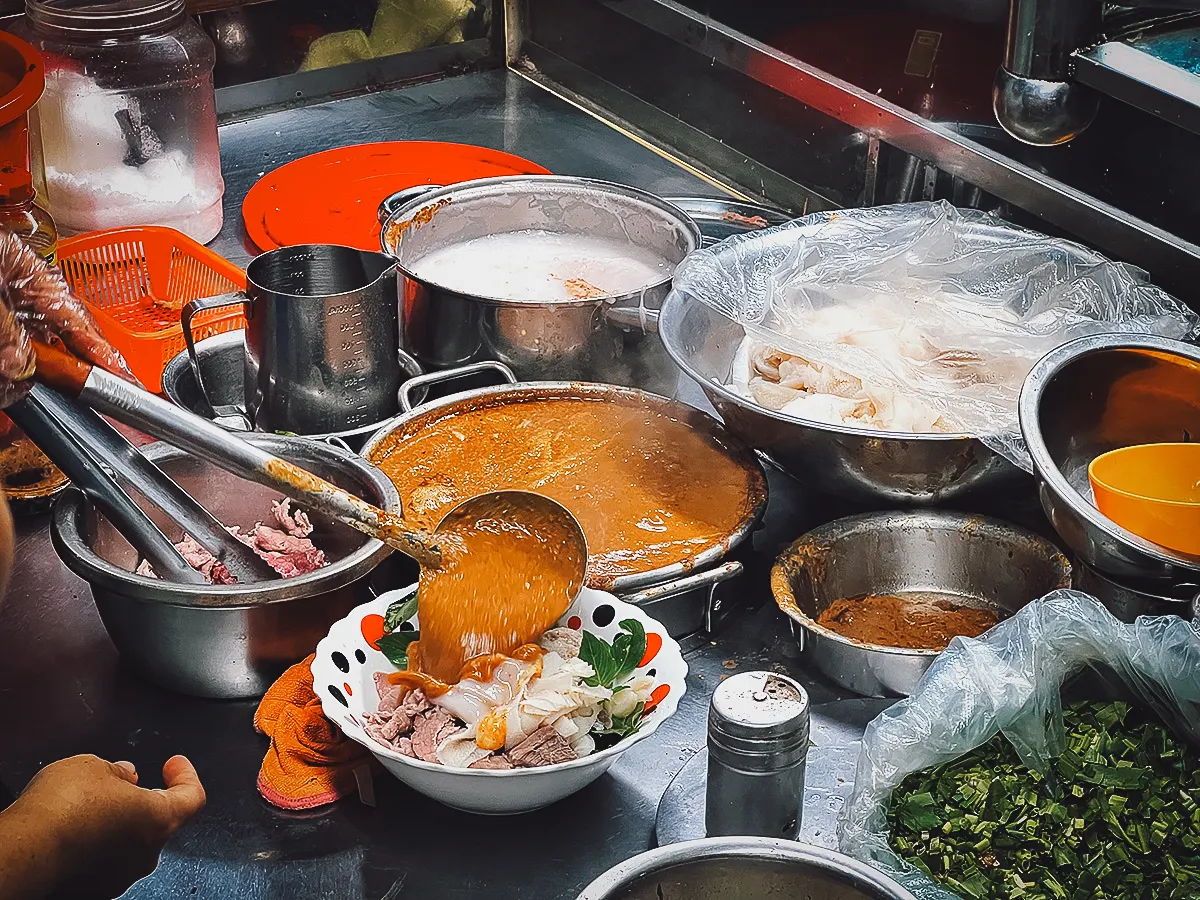
The soup is thick, nutty, and fragrant, yet not overly spicy. Satay is served separately, allowing diners to adjust the heat themselves.
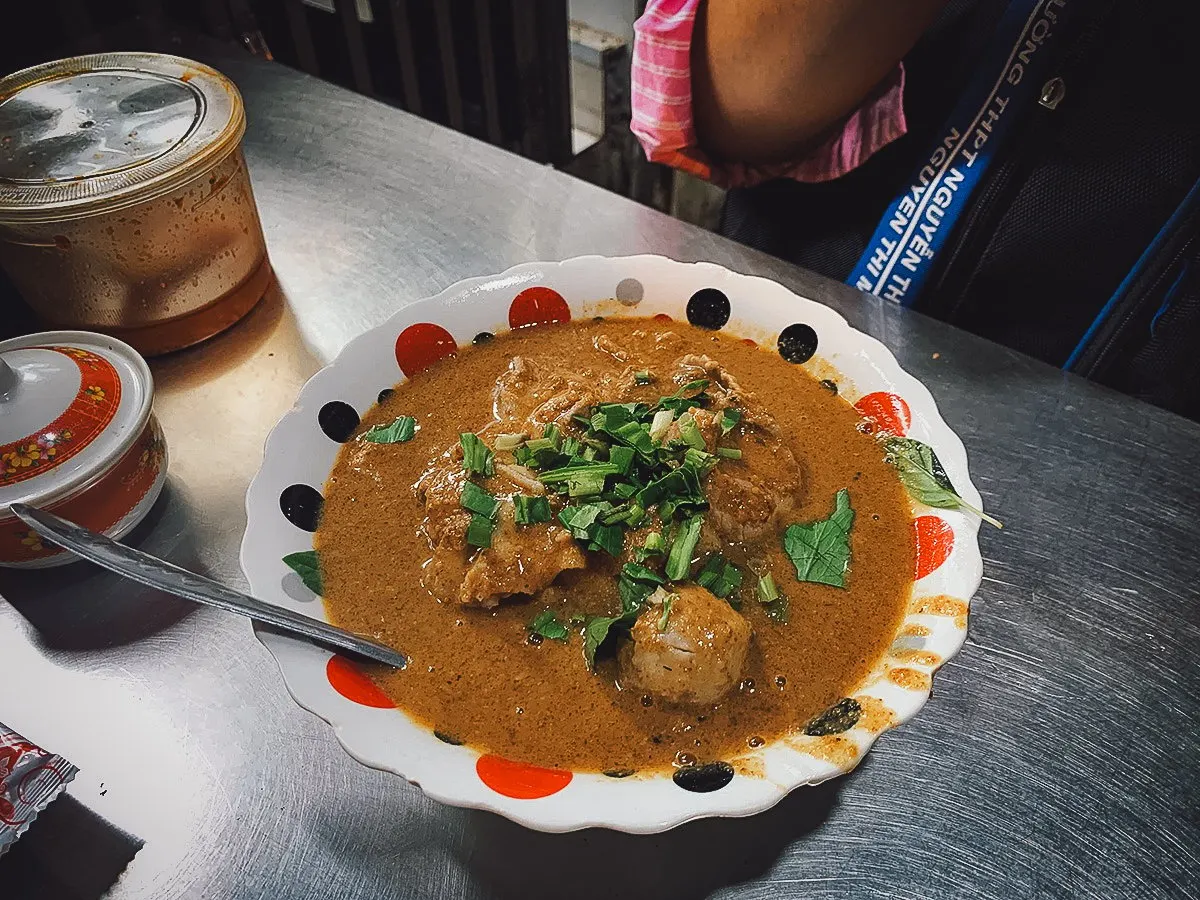
The noodles are wide, fresh rice noodles that resemble northern-style phở. Each bowl comes with thin slices of tender venison, and diners can add beef tendon, tripe, or meatballs in a deluxe version.
The dish is served with herbs such as Thai basil and sawtooth coriander, plus a small bowl of giấm Tiều, a Teochew-style vinegar mixed with chili and galangal. Locals use it to dip the meat, which adds a tangy brightness that balances the richness of the broth.
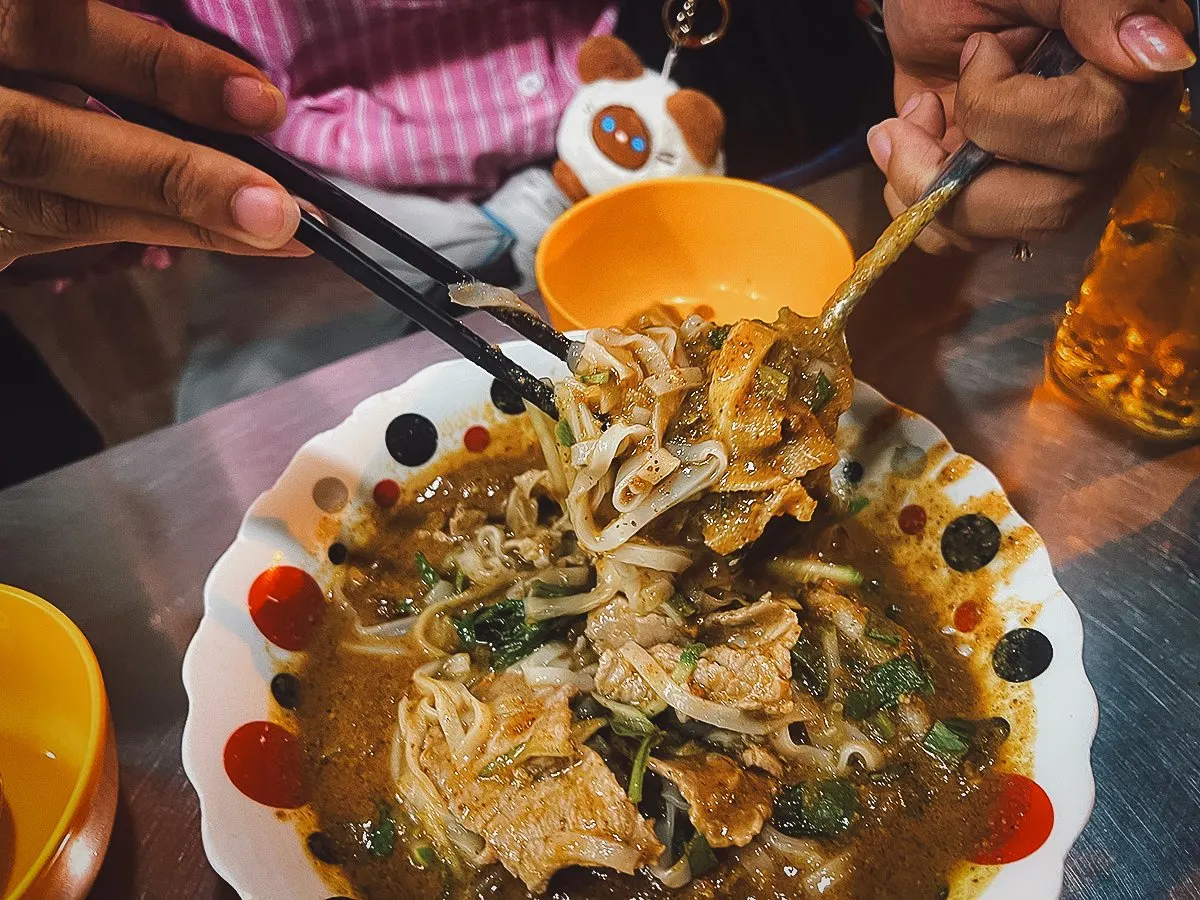
The shop is located behind Chợ Lớn Market and has a modest setup. Stainless steel tables sit under the house awning while the broth pot and prep counter face the street. Though the space is simple, it is clean and well-kept, and you can see your bowl being prepared as you wait. During peak hours, the place often fills up with regulars from the neighborhood and food lovers from other districts who come to enjoy a rare local specialty.
Just a few streets away, other siblings from the same family run their own versions of Tô Ký, each with its own touch. Some say the broth at 36 Gia Phú Street leans sweeter. Others swear by the boldness of the branch at 78 Chu Văn An Street. Another quieter location sits at 25 Nguyễn Trãi Street, serving regulars from nearby schools and shops. But for many, this original shop on 36 Gò Công Street remains the one they always return to.

Hủ tiếu sa tế Tô Ký
Address: 36 Go Cong Street, District 5, Ho Chi Minh City
Opening hours: 6AM-10:30PM
2. Cơm Gà Thanh (Thanh’s crispy chicken rice)
Cơm Gà Thanh, also known as Cơm Gà Xối Mỡ Thanh, is a beloved family-run spot that has served locals for over twenty years. Tucked inside a narrow alley just off Nguyễn Trãi Street near Trần Bình Trọng, the shop’s simple signage might be easy to miss. But as evening approaches, the alley lights up and the tables quickly fill. The later it gets, the busier it becomes. It’s a favorite for Saigon’s night owls, especially since the shop only opens in the late afternoon and runs into the night.
The owner, Uncle Thanh, is a second-generation Chinese-Vietnamese who runs the kitchen with his family. The dishes reflect deep-rooted Cantonese flavors, while still being approachable for local Vietnamese tastes.
Though the name highlights chicken, many regulars come back for the cơm heo chiên xù (crispy pork cutlet rice). Thin pork slices are marinated with soy sauce and garlic, coated in breadcrumbs, and fried until golden and crisp. The crust has a satisfying crunch, while the meat inside stays juicy and tender.
The pork is served over their signature fried rice, which has a warm reddish color from garlic oil, soy, and egg. This rice is not greasy. It’s fragrant, slightly chewy, and packed with flavor. On the side, a small bowl of sweet and sour sauce made with pineapple brings brightness, and a few slices of pickled vegetables help refresh your palate.
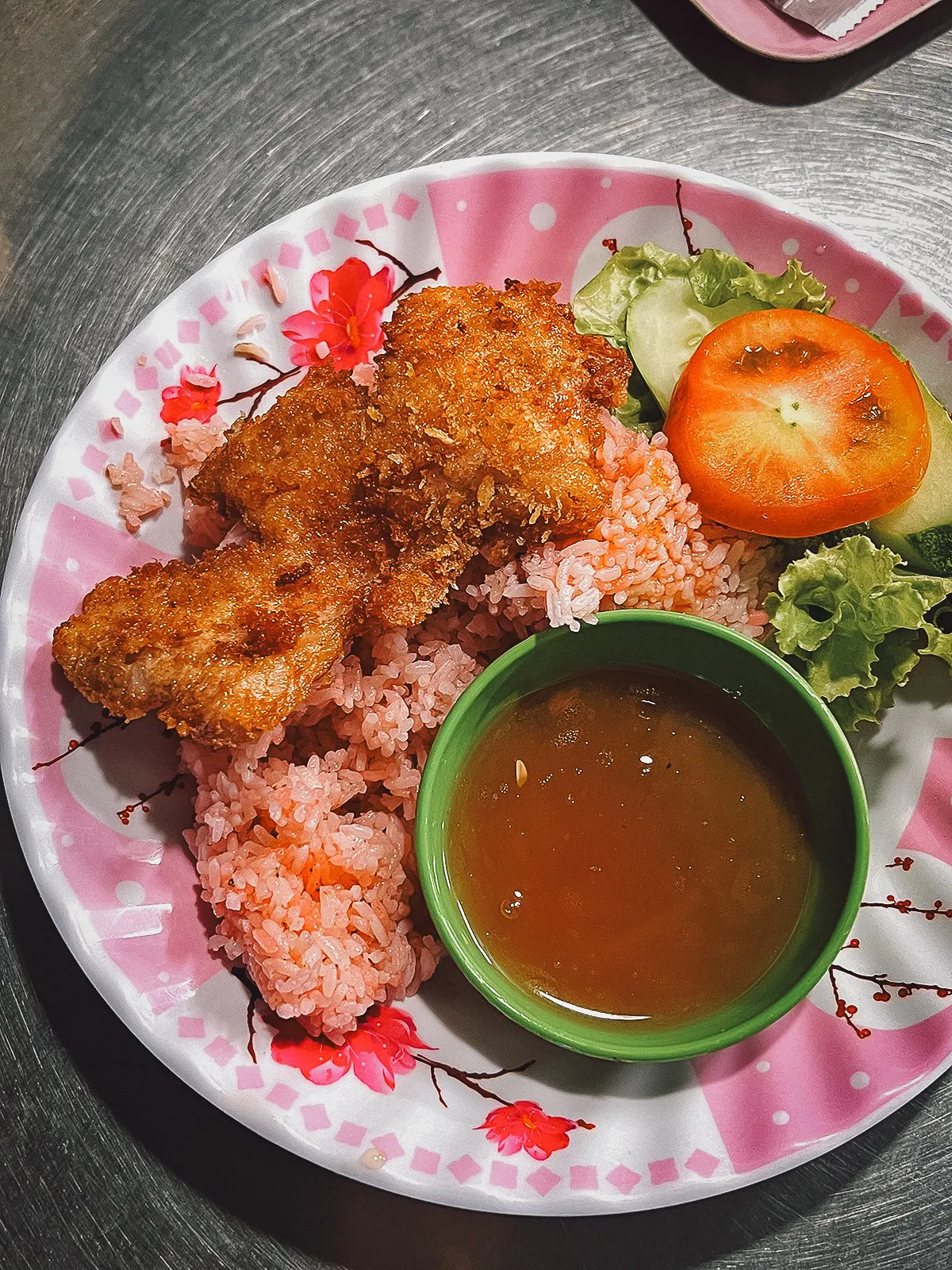
The menu is wider than most casual rice shops nearby. You’ll find Yangzhou fried rice, crispy noodles, stir-fried hủ tiếu, wonton soup, shrimp and squid with vegetables, and even Chinese breakfast items. Still, the cơm gà xối mỡ remains their signature dish.
If you’ve had the chicken rice at Cơm Gà San San and enjoyed it, don’t skip this one. You might find the flavor here deeper, the chicken skin crisper, and the rice more balanced. The chicken is carefully ladled with hot oil until the skin turns golden, then served with the same garlic-soy rice and a special dipping sauce the family has perfected over time.
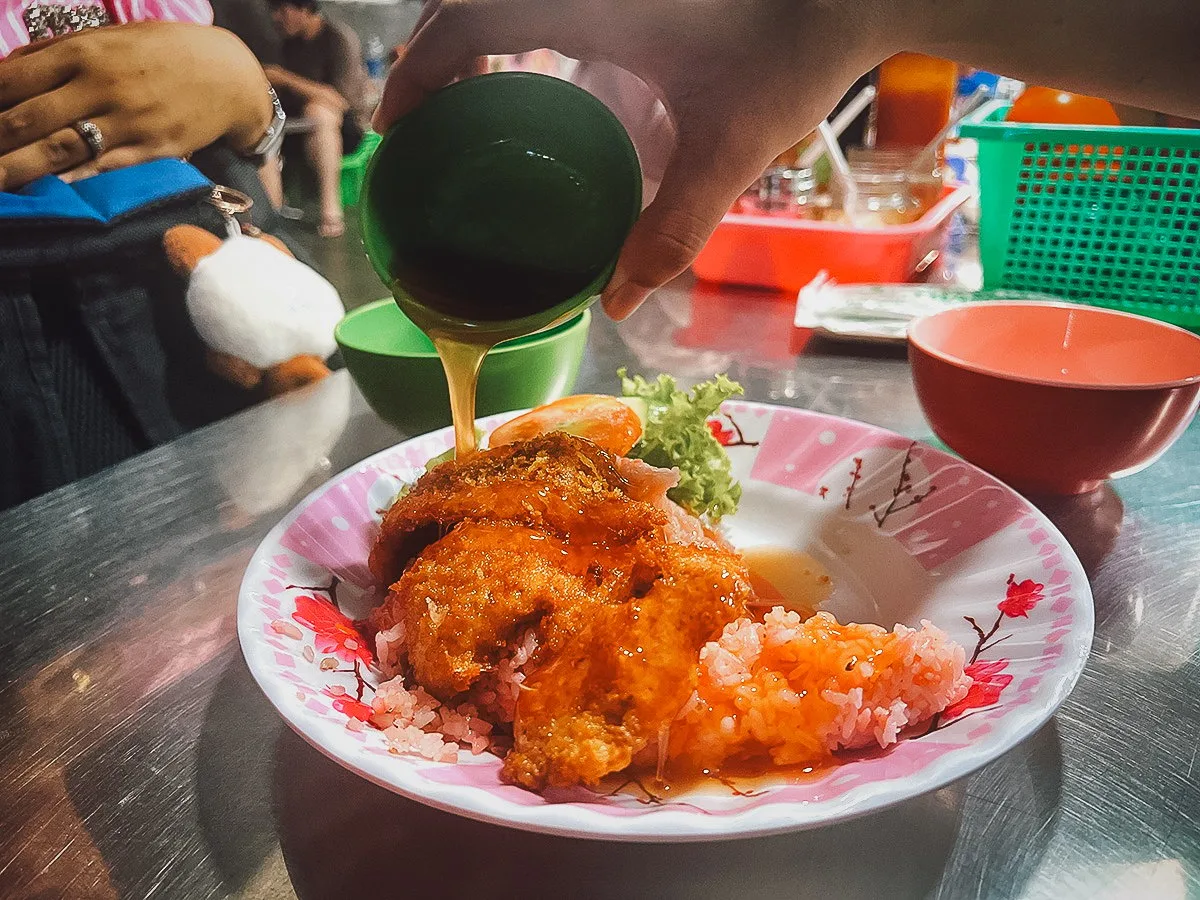
Prices are affordable. Each dish comes in two sizes, so you can go light or share with a friend. Iced tea is always offered at no charge. Despite the tucked-away location, the place fills up every night. Most people who come once find a reason to come back.
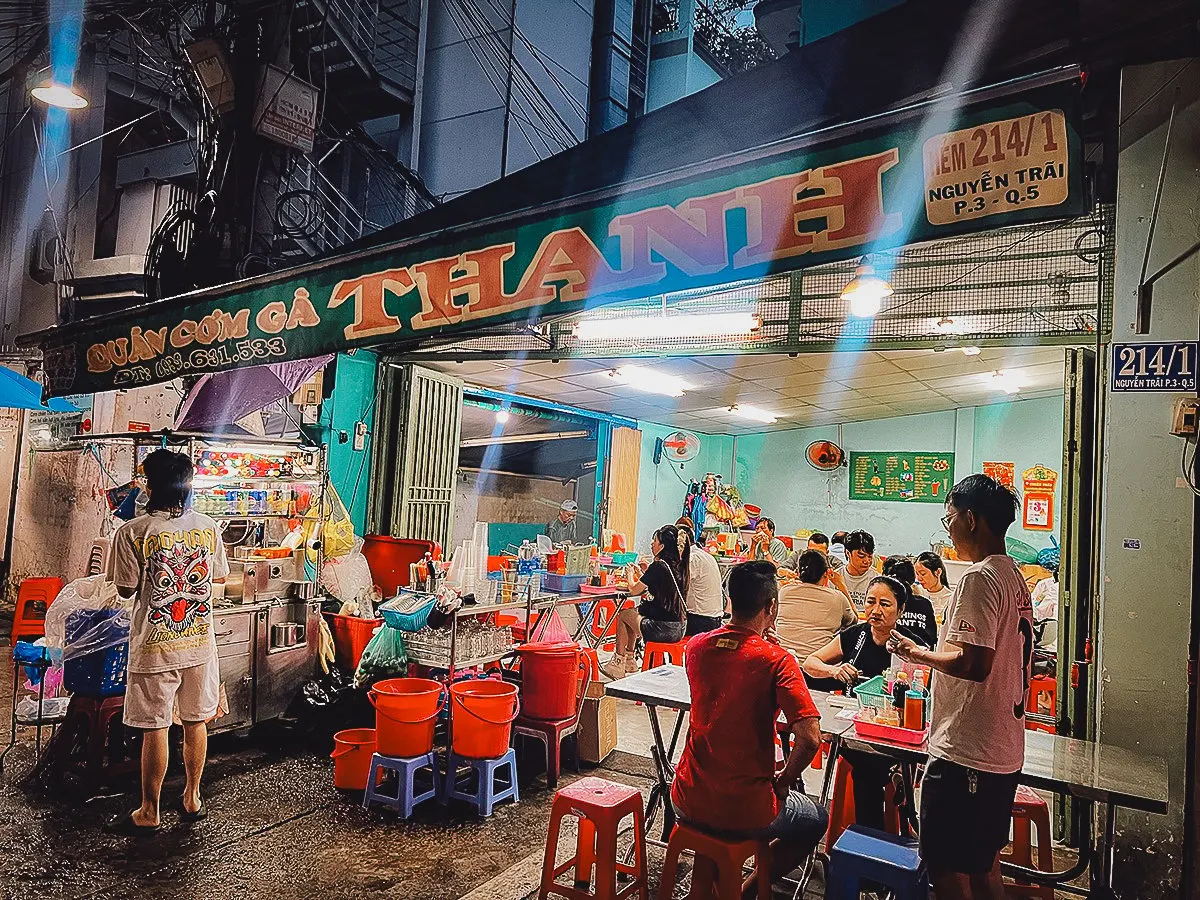
Cơm Gà Thanh
Address: Alley 214 Nguyen T rai, District 5, Ho Chi Minh City
Opening hours: 3-11PM
3. Mì vịt tiềm, sủi cảo Sâm Ký (Sam Ky duck noodles and dumplings)
Sâm Ký is a beloved noodle shop hidden inside a narrow alley of Nguyễn Trãi Street in District 5. It has been serving Saigon’s late-night food lovers for over two decades. The shop was founded by Mr. Sâm and is now run by his family. Like many traditional Chinese eateries in Vietnam, the name comes from the owner’s name combined with “Ký,” meaning “the shop of.”
Originally just a small noodle cart, the shop slowly expanded. Today, it occupies a stretch of the alley by borrowing spaces from neighboring houses. You might see plastic stools in front of one home, metal chairs in front of another, but they all belong to Sâm Ký. In return, the neighbors are allowed to sell drinks like sugarcane juice or herbal tea to diners.
The must-try dish here is sủi cảo (Teochew-style dumplings), plump dumplings made fresh daily. Each is filled with minced pork and a whole shrimp, wrapped in thin dough and served in your choice of three broths.
There’s the classic pork bone broth, a richer herbal soup drawn from the duck stew, or a tangy reddish broth made from salted plum and pork hock. Locals often recommend starting with the clear version to taste the filling fully, then coming back to explore the rest.
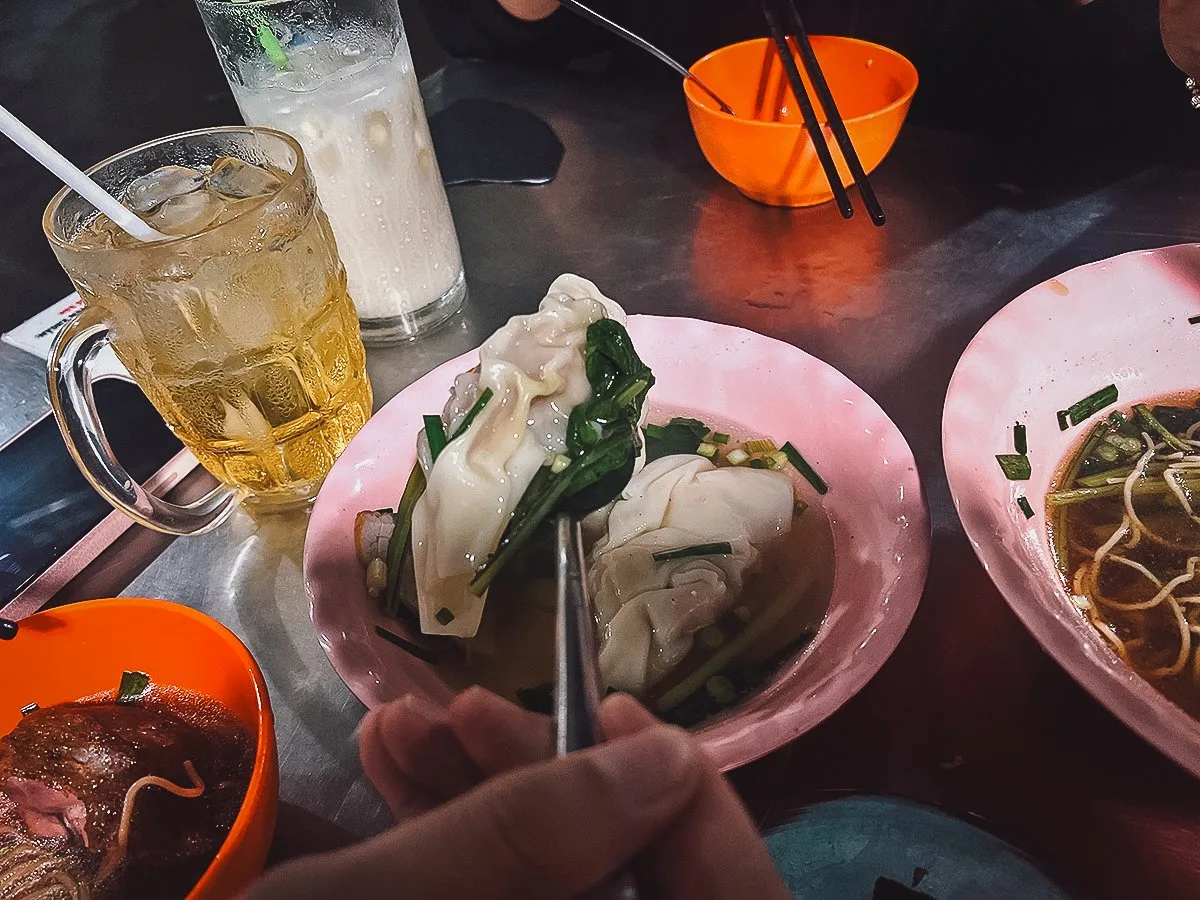
Their second specialty, mì vịt tiềm (herbal braised duck noodles), is equally beloved. A whole duck leg is first marinated, then fried until crisp, and finally simmered in a dark, aromatic broth with Chinese herbs and shiitake mushrooms.
The duck is rich and fall-off-the-bone tender. It’s paired with springy yellow noodles and sometimes extra mustard greens, which regulars often request. Every bowl comes with complimentary blanched vegetables and hot tea, though drinks from neighbors are paid for separately.
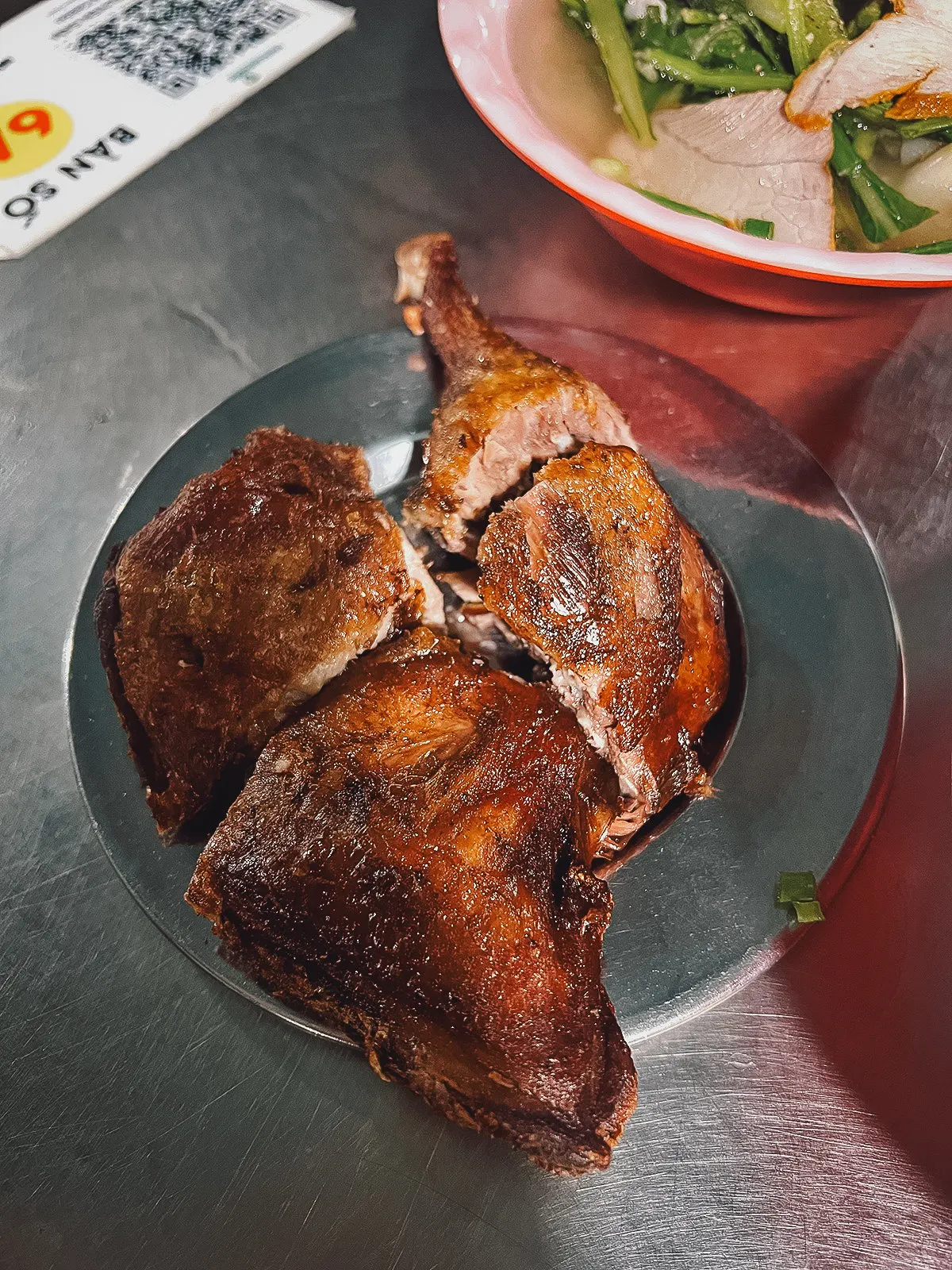
Most locals don’t order from a printed menu. Instead, they call out combinations like “mì sủi cảo nước tiềm” (dumplings in herbal broth) or “vịt tiềm thêm cải” (duck noodles with extra greens). Free tea and blanched greens are served alongside your meal, though you’ll need to pay separately for any extra drinks from neighboring vendors.
The experience is casual and outdoors. Diners sit on small stools around metal tables, surrounded by steam from bubbling pots and the buzz of conversation. Despite the crowd, service is fast, friendly, and the staff are happy to guide you through the menu if you’re new.
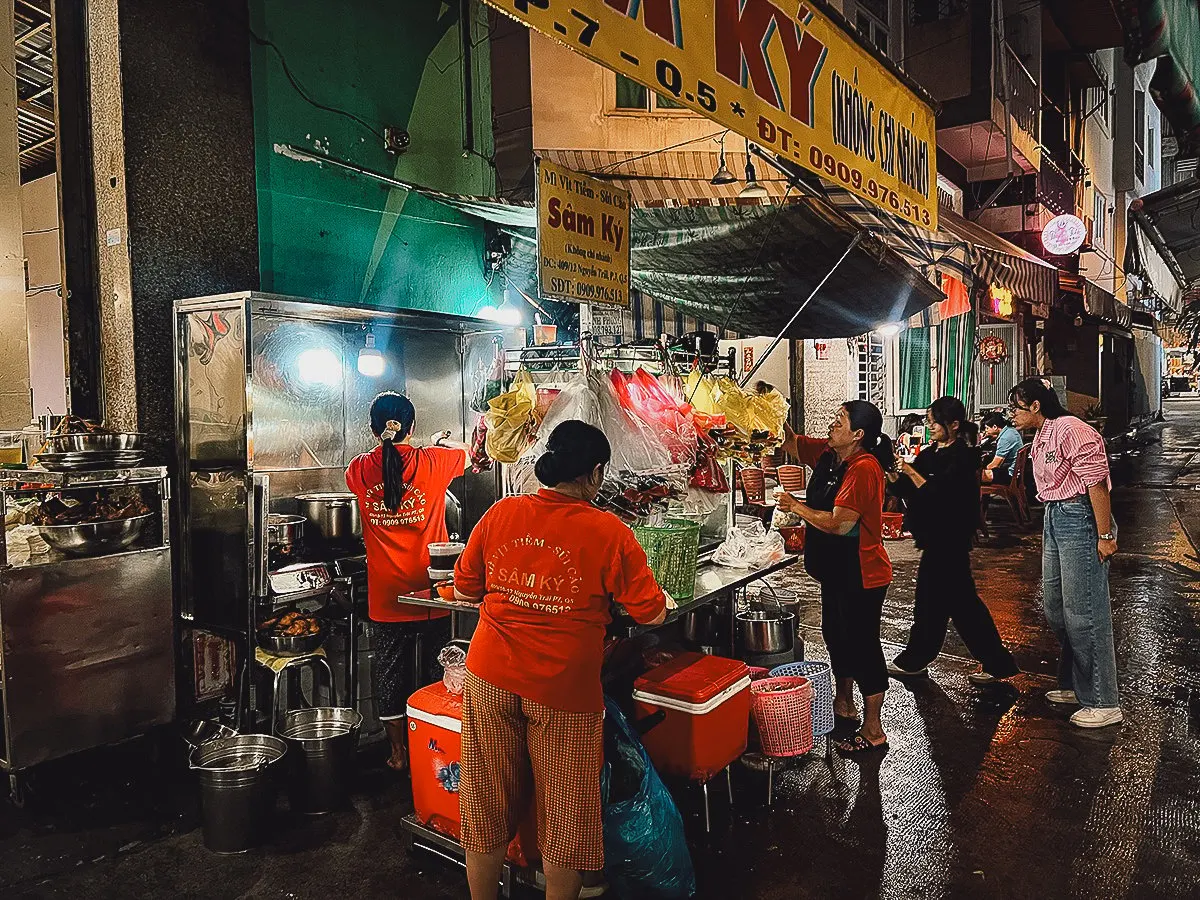
Mì vịt tiềm, sủi cảo Sâm Ký
Address: Alley 409 Nguyễn Trãi Street, District 5, Ho Chi Minh City (near Phở Lệ)
Opening hours: 1-10PM
4. Cháo hải sản Tạ Uyên (Ta Uyen seafood congee)
Cháo 47 Tạ Uyên, also known as Cháo Tiều 47, is a long-standing porridge stall that has earned a loyal following in Saigon’s Chinatown. The stall itself sits on the sidewalk, where the porridge is cooked and served fresh from steaming pots.
A few steps away, the dining area is set up under the front awning of a private home. Stainless steel tables and plastic stools line the shaded walkway, creating a setting that feels informal yet comfortably familiar.
This spot has been around since the 1990s and is known for just two main dishes. The cháo thập cẩm is a richly layered bowl that includes peeled shrimp, squid, fish fillet, pork kidney, pork belly, meatballs, and sometimes century egg.
For something simpler, the cháo hải sản offers just the seafood trio without organ meats. Each ingredient is gently blanched before being added to the hot rice broth, which is cooked the Teochew way. The grains remain whole and tender, floating in a clear, sweet broth that smells of shallots and white pepper.
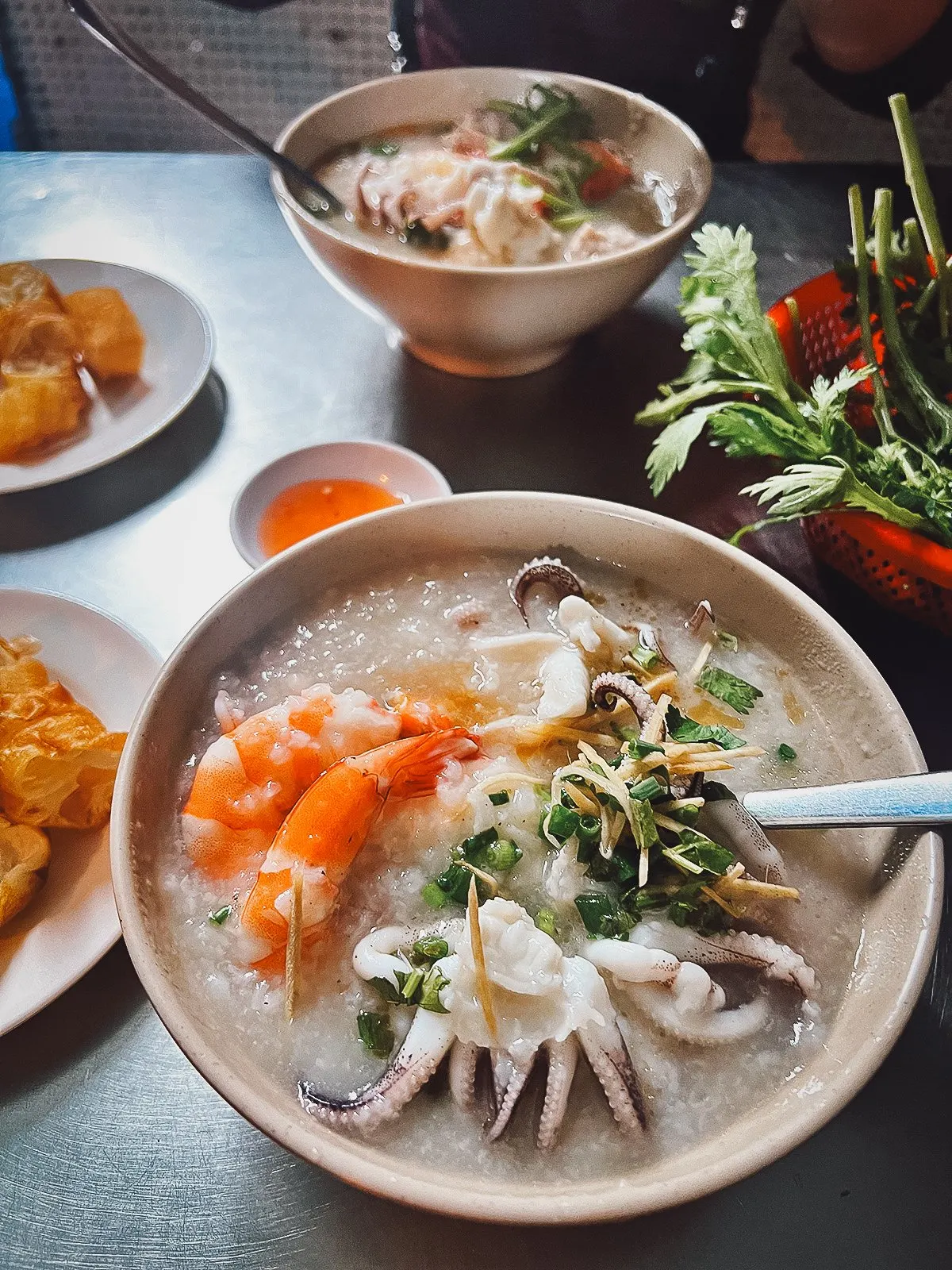
What sets this stall apart is the seafood. The shrimp are large and juicy, the squid is fresh and firm, and the fish slices are clean-tasting and sweet. A small bowl of ginger vinegar dipping sauce is served with every order. It’s not just a condiment but an essential part of how locals eat here. Each bite is dipped before being eaten to bring out the full flavor.
Alongside the porridge, diners are always offered a small plate of rau tần ô (garland chrysanthemum). Lightly blanched, its herbal fragrance lifts the richness of the seafood and adds balance to the meal. It is a humble but meaningful side that regulars never skip.

Prices are a bit higher than at other street porridge spots, ranging from 50,000 VND to 90,000 VND depending on toppings. But most customers agree the quality is worth it. Portions are generous, the ingredients are fresh, and the flavors are thoughtfully layered.
During peak hours, especially from 7PM to 9PM, the space fills quickly. Still, service is fast and efficient, managed entirely by family members.
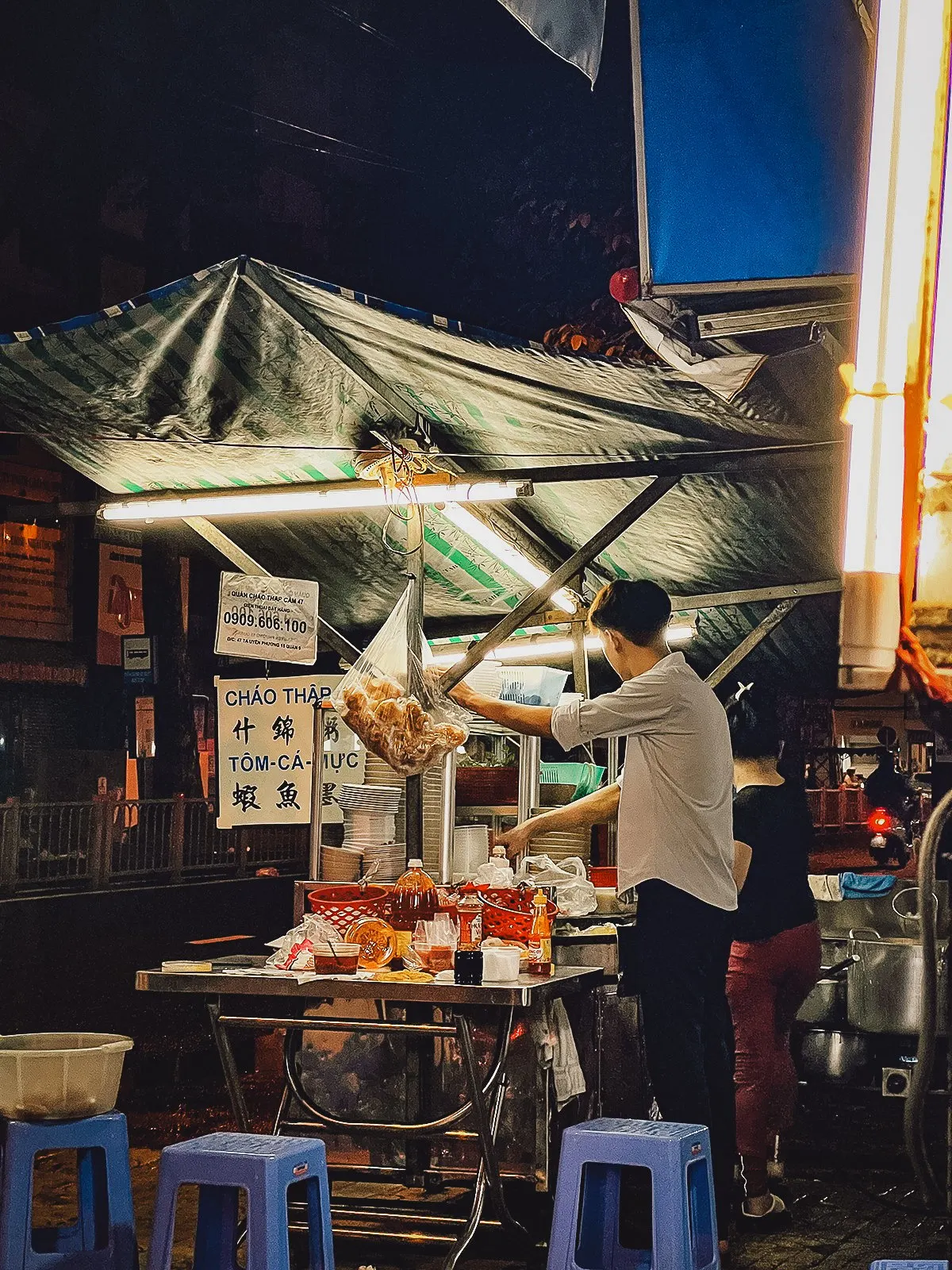
Cháo hải sản Tạ Uyên
Address: 47 T a Uyen, District 5, Ho Chi Minh City
Opening hours: 4:30-11:30PM
5. Chè Hà Ký (Ha Ky traditional sweet soup)
In a city where desserts are often icy and fleeting, Chè Hà Ký offers something slower and deeper. This family-run spot began as a modest cart more than thirty years ago and has since become a quiet legend in District 5. It now sits inside a classic Chợ Lớn shophouse, where five or six indoor tables spill out onto the sidewalk, and the aroma of roasted sesame and simmered herbs draws regulars in from the street.
The shop is now run by Ms. Phan Tiêu Hà, daughter of the founder, who still prepares the desserts using family recipes. Each bowl feels rooted in tradition.
The sesame paste (chè mè đen) is roasted until fragrant, ground fine, and stirred into a glossy, jet-black pudding. The tea-stewed egg (hột gà trà) is infused with warm, herbal notes that feel closer to a remedy than a dessert. The herbal jelly (quy phục linh), served with honey or milk, is bitter at first, then smooth.
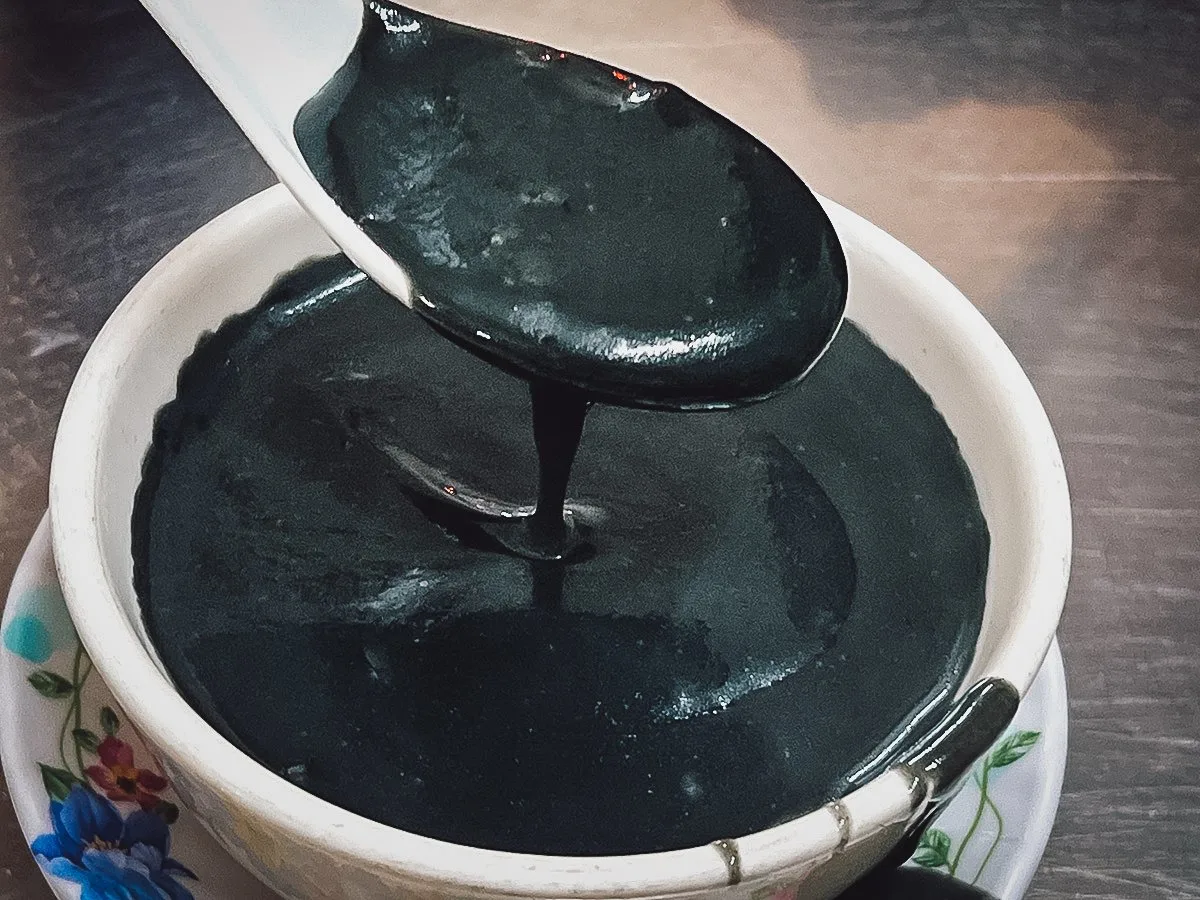
The menu stretches across forty options, neatly divided into hot and cold dishes. You’ll find lotus seed soup, longan with seaweed, almond tofu, red and mung bean chè, and even savory vegetarian snacks like bánh tằm bì and bánh cuốn chay. Most desserts range between 25,000 and 40,000 VND, depending on complexity.

Locals often order two or three bowls to share. The sweetness is always restrained, allowing the deeper flavors to shine through. A warm pot of herbal tea is quietly brought to each table, not listed on the menu but always served. It helps round out the meal and soothes the stomach after a long day.
At night, the shop gets busiest after 8PM, when families drop in, couples stop by, and curious newcomers come to see what Saigon’s Chinatown has been sipping for decades.

Chè Hà Ký
Address: 138 Chau Van Liem, District 5, Ho Chi Minh City
Opening hours: 10AM-10:30PM
FINAL THOUGHTS
You could spend a week here and still not taste everything, still not hear all the stories written in faded Chinese characters above a doorway or whispered behind bowls of soup. That’s what makes District 5 unforgettable.
If you’ve made it this far, you already know this isn’t a list for checking boxes. It’s for those who want to sit a little longer, listen a little more, and eat the way locals do.
Start with the venison satay noodle soup at Hủ Tiếu Sa Tế Tô Ký. Find the red fried rice and crispy pork cutlet at Cơm Gà Thanh. Follow the steam down an alley to the dumplings and duck noodles at Sâm Ký. Sit on the curb at Cháo Tạ Uyên, where seafood porridge warms more than your stomach. And end your night with black sesame, lotus, or herbal jelly at Chè Hà Ký.
These are not the trendiest places in town. But they have quietly fed generations. And if you let them, they will tell you more than any guidebook ever could.
If that kind of travel speaks to you, Jackfruit Adventure offers cycling tours in Ho Chi Minh City designed for those who want to go slow, go local, and go deep.
These are not typical sightseeing routes. Each ride follows the quiet rhythms of real neighborhoods, from morning markets and alleyway kitchens to riverside homes and old temples. Along the way, you’ll meet the people who keep the city’s heart beating and see Saigon through their eyes.
Just like the five eateries above, Jackfruit’s tours aren’t about showing off. They’re about showing you what locals never stopped loving.
Disclosure
This article on the best hidden eateries in Saigon’s Chinatown was written in partnership with Jackfruit Adventure. We look forward to joining one of their cycling tours on our next trip back to Ho Chi Minh City.
